BUS308 - Credit and Lending Decisions: Analysis of First National Corp
VerifiedAdded on 2022/09/28
|19
|5824
|22
Report
AI Summary
This report presents a comprehensive analysis of credit and lending decisions, focusing on First National Corporation and Edward Altman's perspectives. Part A examines First National's asset-based lending practices, its compatibility with corporate image, the impact of its lending on return on net worth and assets, and the significance of deposit composition in identifying high-yield earning assets. It also explores the bank's venture into asset-based lending before the global financial crisis. Part B delves into Edward Altman's insights on the credit cycle. The report provides detailed answers to specific questions, supported by relevant references and an executive summary. The analysis considers the evolution of asset-based lending, the importance of financial ratios, and the implications of lending practices within the context of broader economic trends. It provides insights into the risks and rewards associated with different lending strategies and their impact on financial performance.
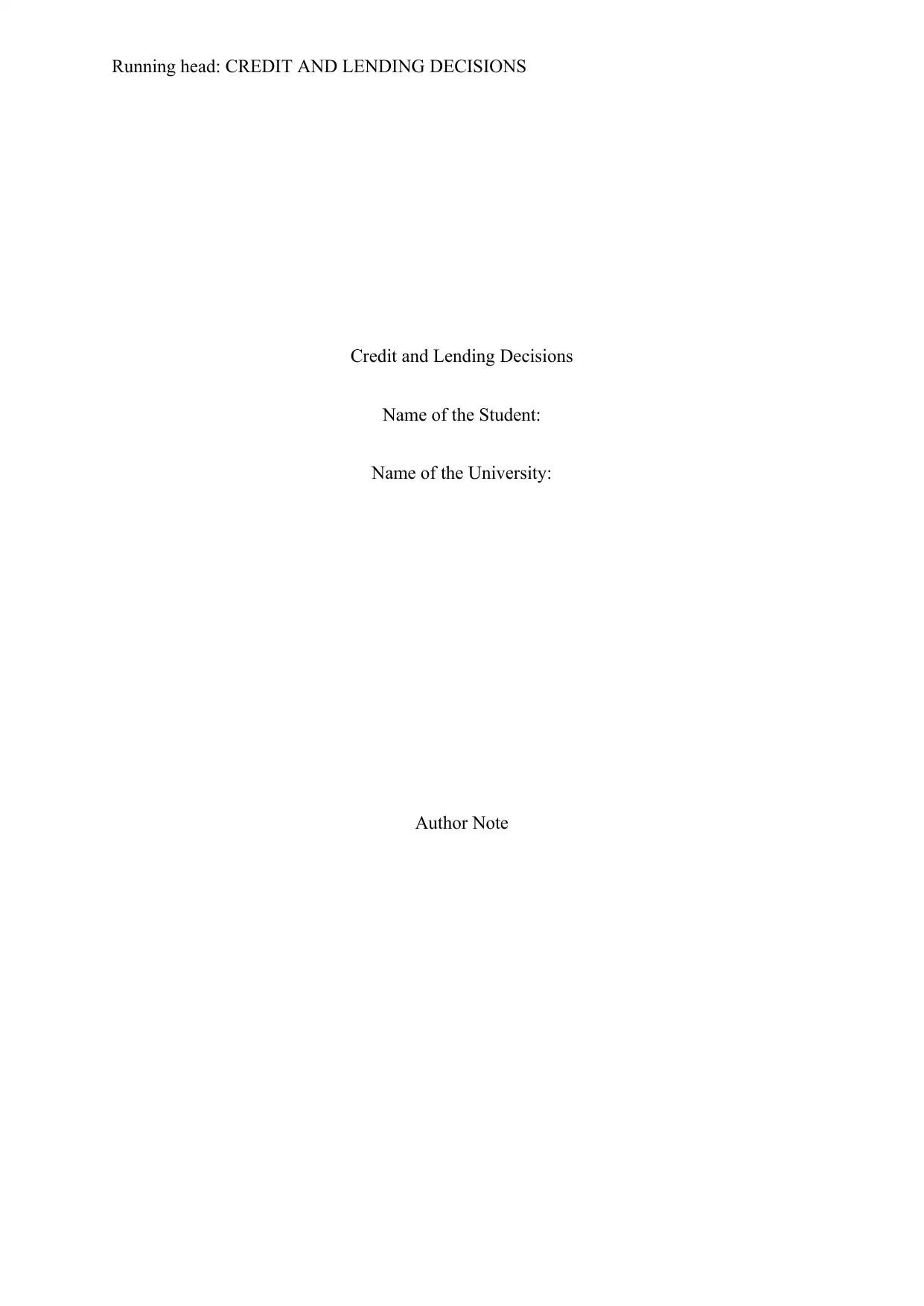
Running head: CREDIT AND LENDING DECISIONS
Credit and Lending Decisions
Name of the Student:
Name of the University:
Author Note
Credit and Lending Decisions
Name of the Student:
Name of the University:
Author Note
Paraphrase This Document
Need a fresh take? Get an instant paraphrase of this document with our AI Paraphraser
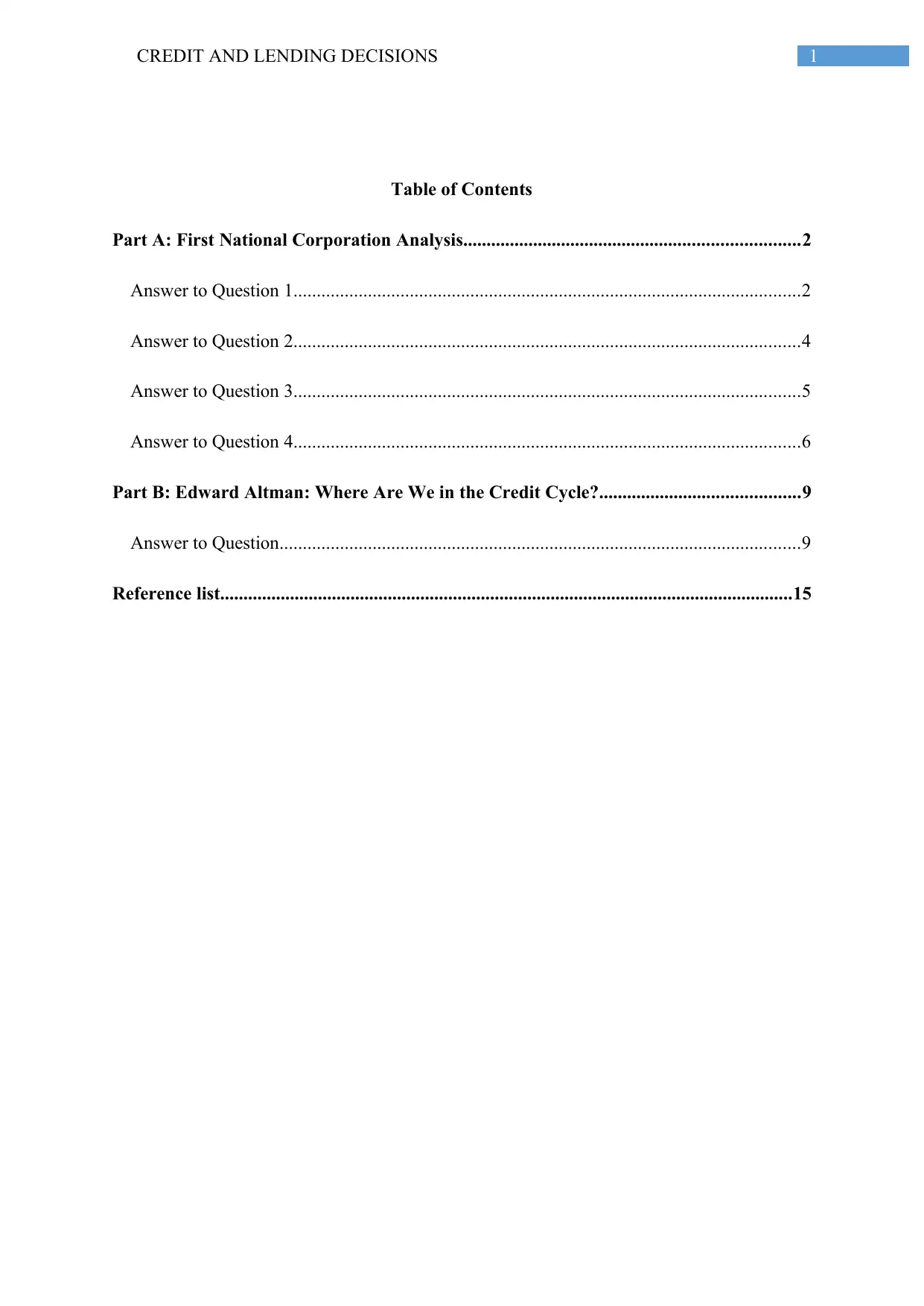
1CREDIT AND LENDING DECISIONS
Table of Contents
Part A: First National Corporation Analysis........................................................................2
Answer to Question 1.............................................................................................................2
Answer to Question 2.............................................................................................................4
Answer to Question 3.............................................................................................................5
Answer to Question 4.............................................................................................................6
Part B: Edward Altman: Where Are We in the Credit Cycle?...........................................9
Answer to Question................................................................................................................9
Reference list...........................................................................................................................15
Table of Contents
Part A: First National Corporation Analysis........................................................................2
Answer to Question 1.............................................................................................................2
Answer to Question 2.............................................................................................................4
Answer to Question 3.............................................................................................................5
Answer to Question 4.............................................................................................................6
Part B: Edward Altman: Where Are We in the Credit Cycle?...........................................9
Answer to Question................................................................................................................9
Reference list...........................................................................................................................15
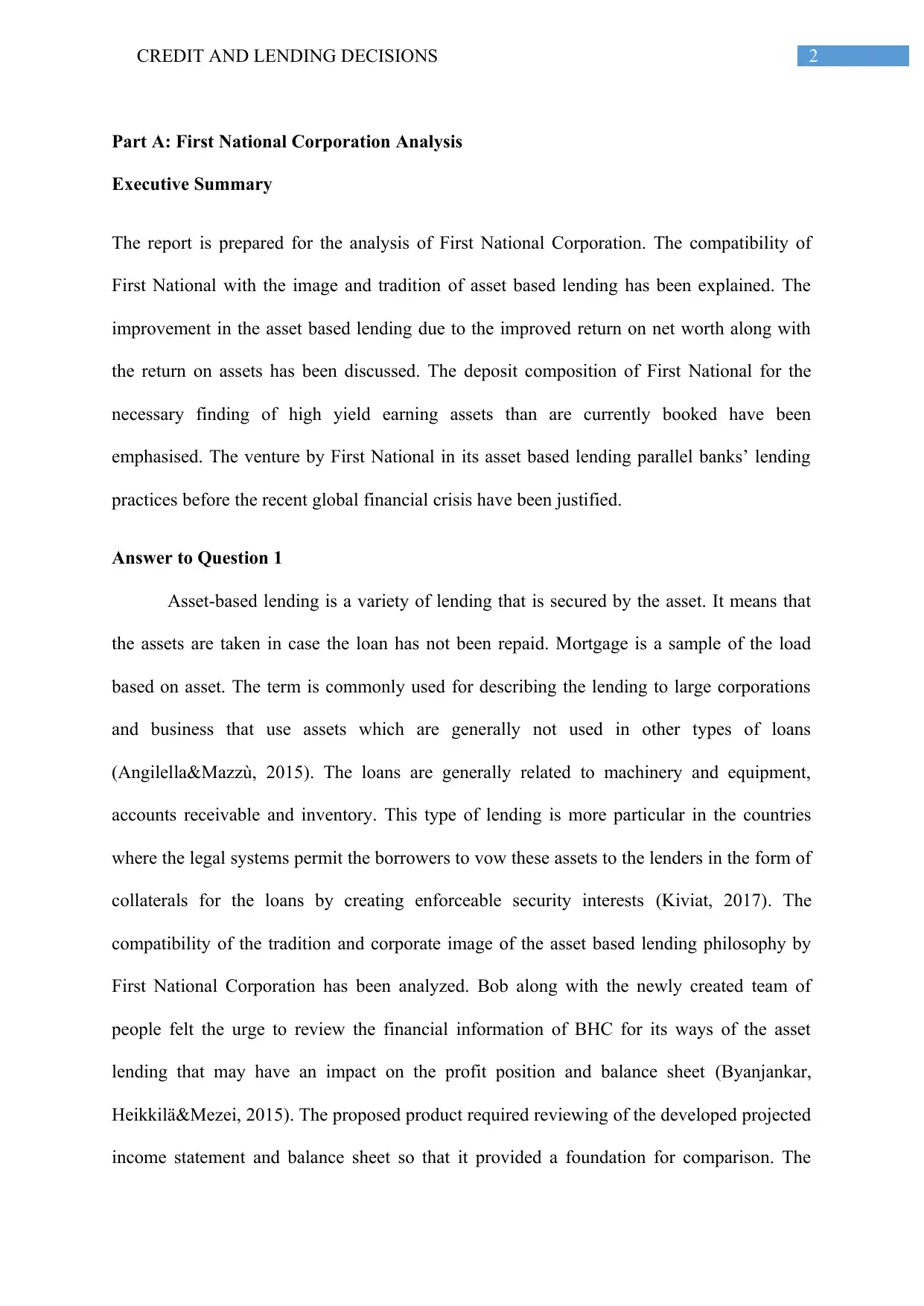
2CREDIT AND LENDING DECISIONS
Part A: First National Corporation Analysis
Executive Summary
The report is prepared for the analysis of First National Corporation. The compatibility of
First National with the image and tradition of asset based lending has been explained. The
improvement in the asset based lending due to the improved return on net worth along with
the return on assets has been discussed. The deposit composition of First National for the
necessary finding of high yield earning assets than are currently booked have been
emphasised. The venture by First National in its asset based lending parallel banks’ lending
practices before the recent global financial crisis have been justified.
Answer to Question 1
Asset-based lending is a variety of lending that is secured by the asset. It means that
the assets are taken in case the loan has not been repaid. Mortgage is a sample of the load
based on asset. The term is commonly used for describing the lending to large corporations
and business that use assets which are generally not used in other types of loans
(Angilella&Mazzù, 2015). The loans are generally related to machinery and equipment,
accounts receivable and inventory. This type of lending is more particular in the countries
where the legal systems permit the borrowers to vow these assets to the lenders in the form of
collaterals for the loans by creating enforceable security interests (Kiviat, 2017). The
compatibility of the tradition and corporate image of the asset based lending philosophy by
First National Corporation has been analyzed. Bob along with the newly created team of
people felt the urge to review the financial information of BHC for its ways of the asset
lending that may have an impact on the profit position and balance sheet (Byanjankar,
Heikkilä&Mezei, 2015). The proposed product required reviewing of the developed projected
income statement and balance sheet so that it provided a foundation for comparison. The
Part A: First National Corporation Analysis
Executive Summary
The report is prepared for the analysis of First National Corporation. The compatibility of
First National with the image and tradition of asset based lending has been explained. The
improvement in the asset based lending due to the improved return on net worth along with
the return on assets has been discussed. The deposit composition of First National for the
necessary finding of high yield earning assets than are currently booked have been
emphasised. The venture by First National in its asset based lending parallel banks’ lending
practices before the recent global financial crisis have been justified.
Answer to Question 1
Asset-based lending is a variety of lending that is secured by the asset. It means that
the assets are taken in case the loan has not been repaid. Mortgage is a sample of the load
based on asset. The term is commonly used for describing the lending to large corporations
and business that use assets which are generally not used in other types of loans
(Angilella&Mazzù, 2015). The loans are generally related to machinery and equipment,
accounts receivable and inventory. This type of lending is more particular in the countries
where the legal systems permit the borrowers to vow these assets to the lenders in the form of
collaterals for the loans by creating enforceable security interests (Kiviat, 2017). The
compatibility of the tradition and corporate image of the asset based lending philosophy by
First National Corporation has been analyzed. Bob along with the newly created team of
people felt the urge to review the financial information of BHC for its ways of the asset
lending that may have an impact on the profit position and balance sheet (Byanjankar,
Heikkilä&Mezei, 2015). The proposed product required reviewing of the developed projected
income statement and balance sheet so that it provided a foundation for comparison. The
⊘ This is a preview!⊘
Do you want full access?
Subscribe today to unlock all pages.

Trusted by 1+ million students worldwide
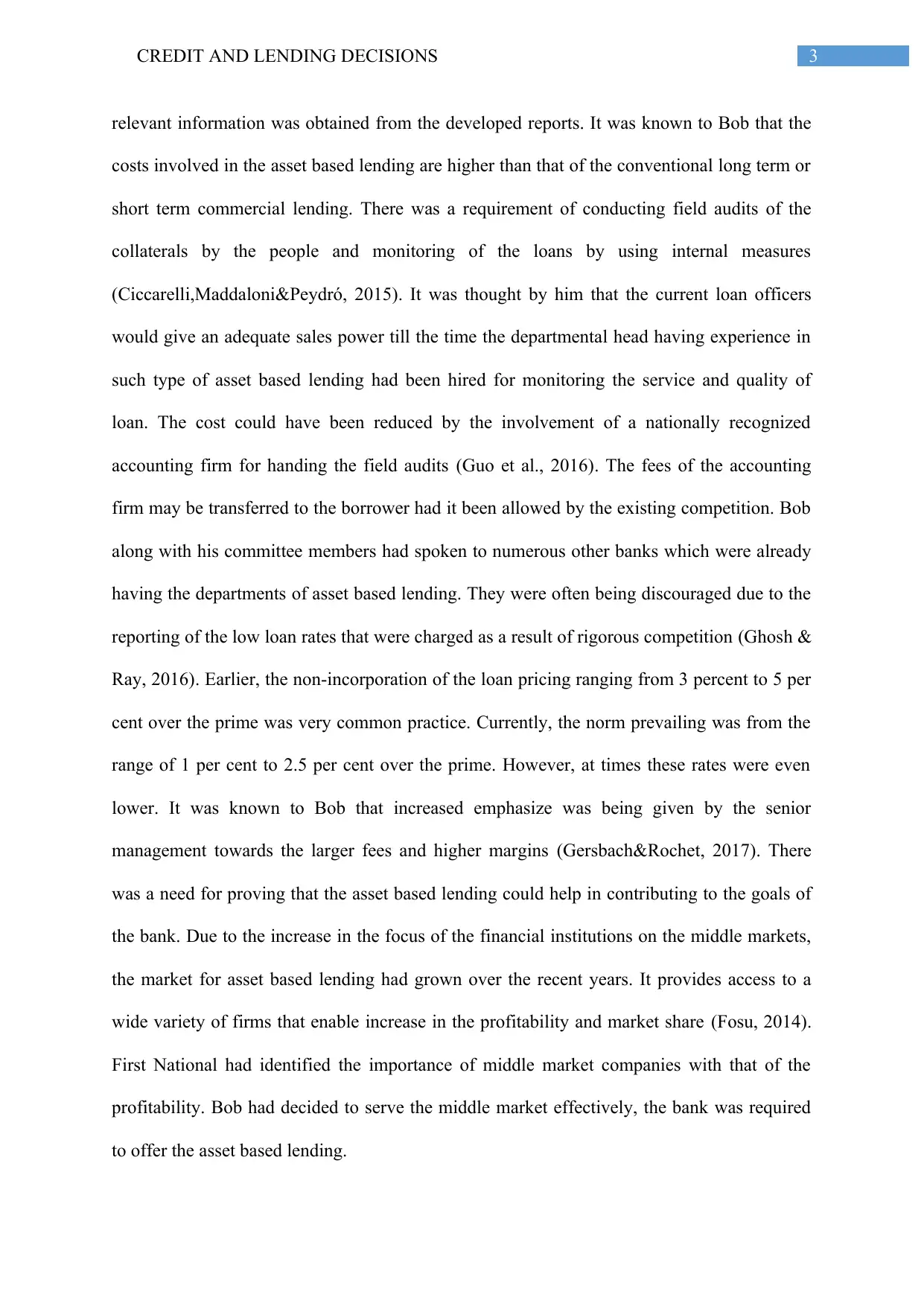
3CREDIT AND LENDING DECISIONS
relevant information was obtained from the developed reports. It was known to Bob that the
costs involved in the asset based lending are higher than that of the conventional long term or
short term commercial lending. There was a requirement of conducting field audits of the
collaterals by the people and monitoring of the loans by using internal measures
(Ciccarelli,Maddaloni&Peydró, 2015). It was thought by him that the current loan officers
would give an adequate sales power till the time the departmental head having experience in
such type of asset based lending had been hired for monitoring the service and quality of
loan. The cost could have been reduced by the involvement of a nationally recognized
accounting firm for handing the field audits (Guo et al., 2016). The fees of the accounting
firm may be transferred to the borrower had it been allowed by the existing competition. Bob
along with his committee members had spoken to numerous other banks which were already
having the departments of asset based lending. They were often being discouraged due to the
reporting of the low loan rates that were charged as a result of rigorous competition (Ghosh &
Ray, 2016). Earlier, the non-incorporation of the loan pricing ranging from 3 percent to 5 per
cent over the prime was very common practice. Currently, the norm prevailing was from the
range of 1 per cent to 2.5 per cent over the prime. However, at times these rates were even
lower. It was known to Bob that increased emphasize was being given by the senior
management towards the larger fees and higher margins (Gersbach&Rochet, 2017). There
was a need for proving that the asset based lending could help in contributing to the goals of
the bank. Due to the increase in the focus of the financial institutions on the middle markets,
the market for asset based lending had grown over the recent years. It provides access to a
wide variety of firms that enable increase in the profitability and market share (Fosu, 2014).
First National had identified the importance of middle market companies with that of the
profitability. Bob had decided to serve the middle market effectively, the bank was required
to offer the asset based lending.
relevant information was obtained from the developed reports. It was known to Bob that the
costs involved in the asset based lending are higher than that of the conventional long term or
short term commercial lending. There was a requirement of conducting field audits of the
collaterals by the people and monitoring of the loans by using internal measures
(Ciccarelli,Maddaloni&Peydró, 2015). It was thought by him that the current loan officers
would give an adequate sales power till the time the departmental head having experience in
such type of asset based lending had been hired for monitoring the service and quality of
loan. The cost could have been reduced by the involvement of a nationally recognized
accounting firm for handing the field audits (Guo et al., 2016). The fees of the accounting
firm may be transferred to the borrower had it been allowed by the existing competition. Bob
along with his committee members had spoken to numerous other banks which were already
having the departments of asset based lending. They were often being discouraged due to the
reporting of the low loan rates that were charged as a result of rigorous competition (Ghosh &
Ray, 2016). Earlier, the non-incorporation of the loan pricing ranging from 3 percent to 5 per
cent over the prime was very common practice. Currently, the norm prevailing was from the
range of 1 per cent to 2.5 per cent over the prime. However, at times these rates were even
lower. It was known to Bob that increased emphasize was being given by the senior
management towards the larger fees and higher margins (Gersbach&Rochet, 2017). There
was a need for proving that the asset based lending could help in contributing to the goals of
the bank. Due to the increase in the focus of the financial institutions on the middle markets,
the market for asset based lending had grown over the recent years. It provides access to a
wide variety of firms that enable increase in the profitability and market share (Fosu, 2014).
First National had identified the importance of middle market companies with that of the
profitability. Bob had decided to serve the middle market effectively, the bank was required
to offer the asset based lending.
Paraphrase This Document
Need a fresh take? Get an instant paraphrase of this document with our AI Paraphraser
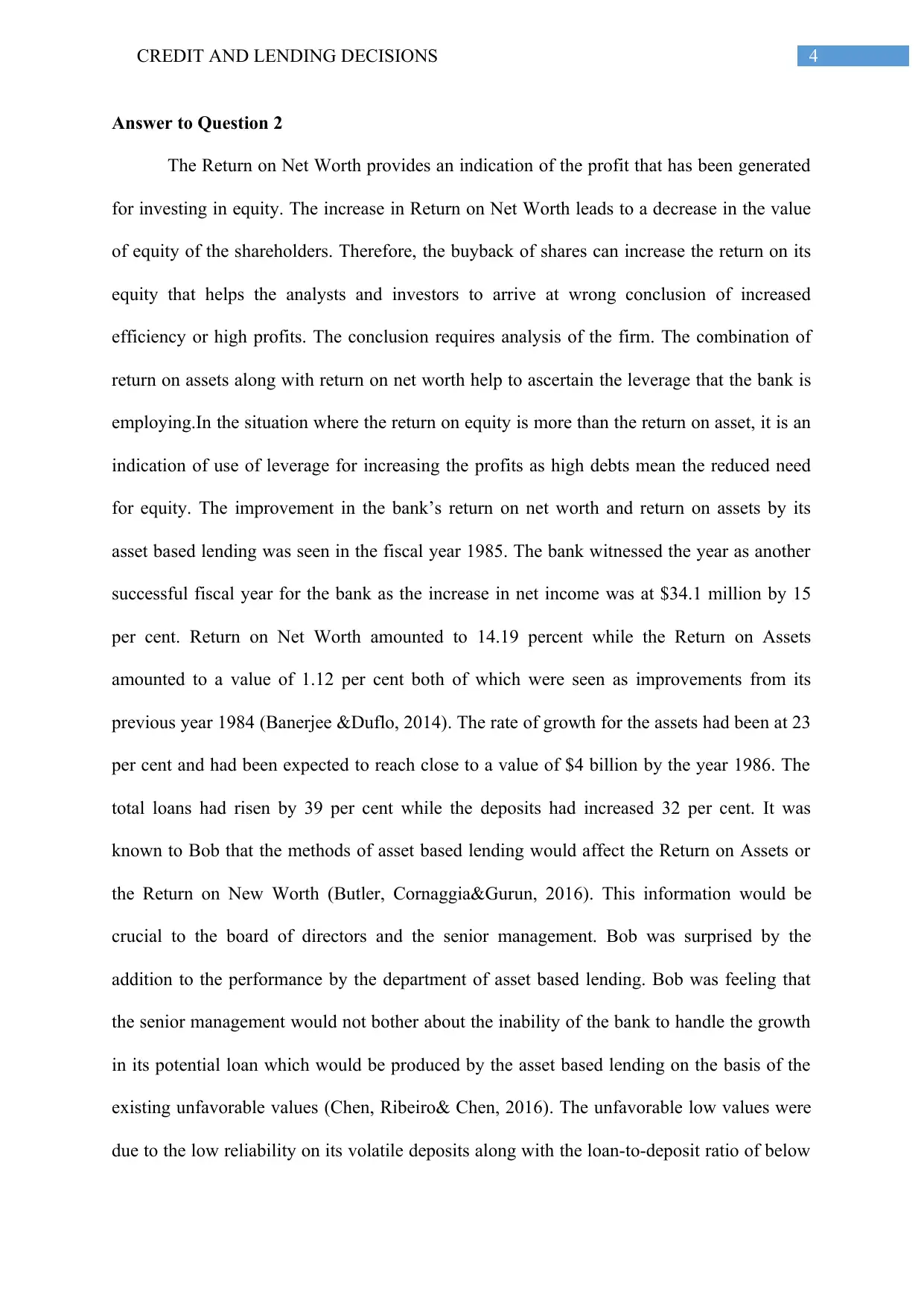
4CREDIT AND LENDING DECISIONS
Answer to Question 2
The Return on Net Worth provides an indication of the profit that has been generated
for investing in equity. The increase in Return on Net Worth leads to a decrease in the value
of equity of the shareholders. Therefore, the buyback of shares can increase the return on its
equity that helps the analysts and investors to arrive at wrong conclusion of increased
efficiency or high profits. The conclusion requires analysis of the firm. The combination of
return on assets along with return on net worth help to ascertain the leverage that the bank is
employing.In the situation where the return on equity is more than the return on asset, it is an
indication of use of leverage for increasing the profits as high debts mean the reduced need
for equity. The improvement in the bank’s return on net worth and return on assets by its
asset based lending was seen in the fiscal year 1985. The bank witnessed the year as another
successful fiscal year for the bank as the increase in net income was at $34.1 million by 15
per cent. Return on Net Worth amounted to 14.19 percent while the Return on Assets
amounted to a value of 1.12 per cent both of which were seen as improvements from its
previous year 1984 (Banerjee &Duflo, 2014). The rate of growth for the assets had been at 23
per cent and had been expected to reach close to a value of $4 billion by the year 1986. The
total loans had risen by 39 per cent while the deposits had increased 32 per cent. It was
known to Bob that the methods of asset based lending would affect the Return on Assets or
the Return on New Worth (Butler, Cornaggia&Gurun, 2016). This information would be
crucial to the board of directors and the senior management. Bob was surprised by the
addition to the performance by the department of asset based lending. Bob was feeling that
the senior management would not bother about the inability of the bank to handle the growth
in its potential loan which would be produced by the asset based lending on the basis of the
existing unfavorable values (Chen, Ribeiro& Chen, 2016). The unfavorable low values were
due to the low reliability on its volatile deposits along with the loan-to-deposit ratio of below
Answer to Question 2
The Return on Net Worth provides an indication of the profit that has been generated
for investing in equity. The increase in Return on Net Worth leads to a decrease in the value
of equity of the shareholders. Therefore, the buyback of shares can increase the return on its
equity that helps the analysts and investors to arrive at wrong conclusion of increased
efficiency or high profits. The conclusion requires analysis of the firm. The combination of
return on assets along with return on net worth help to ascertain the leverage that the bank is
employing.In the situation where the return on equity is more than the return on asset, it is an
indication of use of leverage for increasing the profits as high debts mean the reduced need
for equity. The improvement in the bank’s return on net worth and return on assets by its
asset based lending was seen in the fiscal year 1985. The bank witnessed the year as another
successful fiscal year for the bank as the increase in net income was at $34.1 million by 15
per cent. Return on Net Worth amounted to 14.19 percent while the Return on Assets
amounted to a value of 1.12 per cent both of which were seen as improvements from its
previous year 1984 (Banerjee &Duflo, 2014). The rate of growth for the assets had been at 23
per cent and had been expected to reach close to a value of $4 billion by the year 1986. The
total loans had risen by 39 per cent while the deposits had increased 32 per cent. It was
known to Bob that the methods of asset based lending would affect the Return on Assets or
the Return on New Worth (Butler, Cornaggia&Gurun, 2016). This information would be
crucial to the board of directors and the senior management. Bob was surprised by the
addition to the performance by the department of asset based lending. Bob was feeling that
the senior management would not bother about the inability of the bank to handle the growth
in its potential loan which would be produced by the asset based lending on the basis of the
existing unfavorable values (Chen, Ribeiro& Chen, 2016). The unfavorable low values were
due to the low reliability on its volatile deposits along with the loan-to-deposit ratio of below
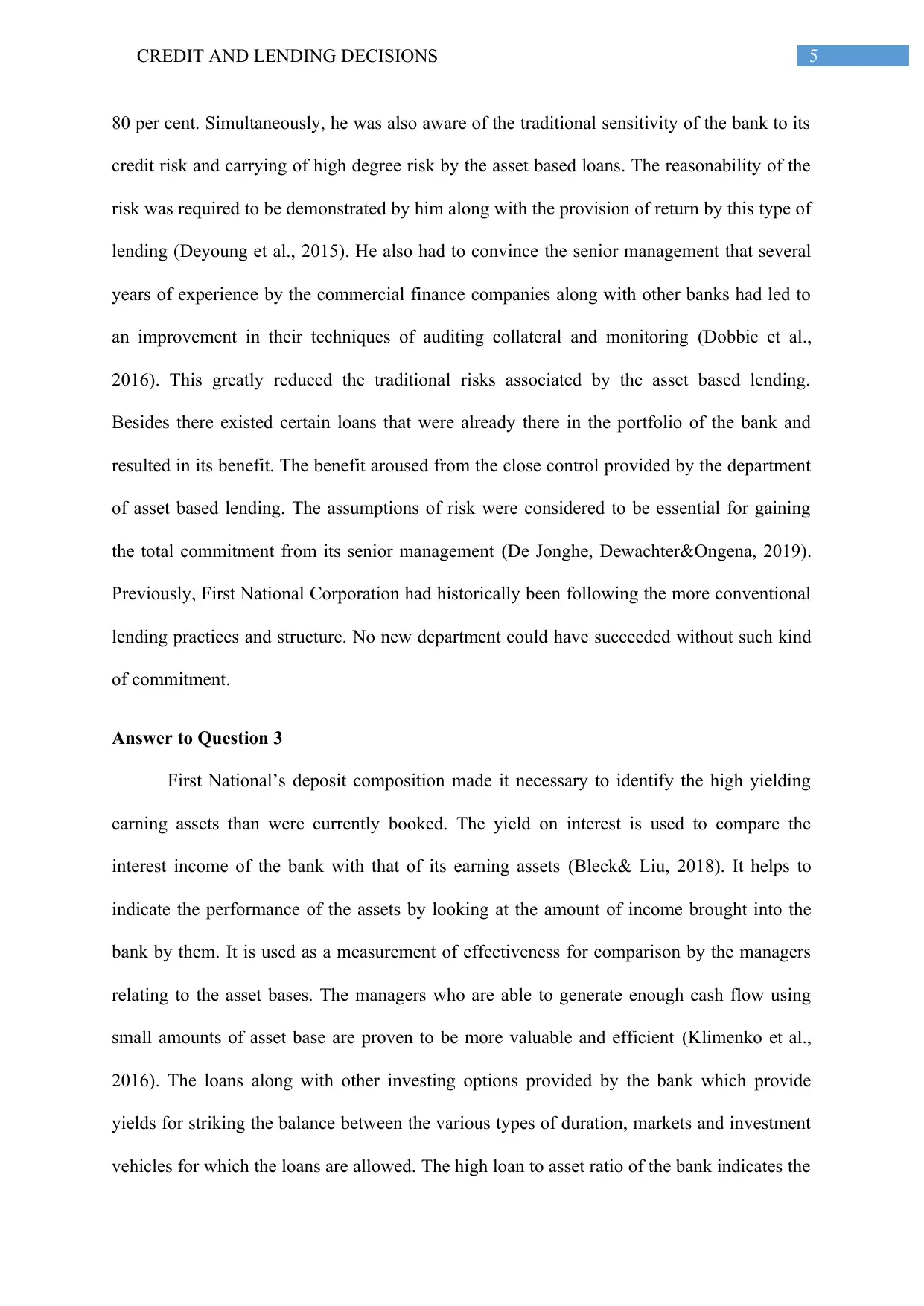
5CREDIT AND LENDING DECISIONS
80 per cent. Simultaneously, he was also aware of the traditional sensitivity of the bank to its
credit risk and carrying of high degree risk by the asset based loans. The reasonability of the
risk was required to be demonstrated by him along with the provision of return by this type of
lending (Deyoung et al., 2015). He also had to convince the senior management that several
years of experience by the commercial finance companies along with other banks had led to
an improvement in their techniques of auditing collateral and monitoring (Dobbie et al.,
2016). This greatly reduced the traditional risks associated by the asset based lending.
Besides there existed certain loans that were already there in the portfolio of the bank and
resulted in its benefit. The benefit aroused from the close control provided by the department
of asset based lending. The assumptions of risk were considered to be essential for gaining
the total commitment from its senior management (De Jonghe, Dewachter&Ongena, 2019).
Previously, First National Corporation had historically been following the more conventional
lending practices and structure. No new department could have succeeded without such kind
of commitment.
Answer to Question 3
First National’s deposit composition made it necessary to identify the high yielding
earning assets than were currently booked. The yield on interest is used to compare the
interest income of the bank with that of its earning assets (Bleck& Liu, 2018). It helps to
indicate the performance of the assets by looking at the amount of income brought into the
bank by them. It is used as a measurement of effectiveness for comparison by the managers
relating to the asset bases. The managers who are able to generate enough cash flow using
small amounts of asset base are proven to be more valuable and efficient (Klimenko et al.,
2016). The loans along with other investing options provided by the bank which provide
yields for striking the balance between the various types of duration, markets and investment
vehicles for which the loans are allowed. The high loan to asset ratio of the bank indicates the
80 per cent. Simultaneously, he was also aware of the traditional sensitivity of the bank to its
credit risk and carrying of high degree risk by the asset based loans. The reasonability of the
risk was required to be demonstrated by him along with the provision of return by this type of
lending (Deyoung et al., 2015). He also had to convince the senior management that several
years of experience by the commercial finance companies along with other banks had led to
an improvement in their techniques of auditing collateral and monitoring (Dobbie et al.,
2016). This greatly reduced the traditional risks associated by the asset based lending.
Besides there existed certain loans that were already there in the portfolio of the bank and
resulted in its benefit. The benefit aroused from the close control provided by the department
of asset based lending. The assumptions of risk were considered to be essential for gaining
the total commitment from its senior management (De Jonghe, Dewachter&Ongena, 2019).
Previously, First National Corporation had historically been following the more conventional
lending practices and structure. No new department could have succeeded without such kind
of commitment.
Answer to Question 3
First National’s deposit composition made it necessary to identify the high yielding
earning assets than were currently booked. The yield on interest is used to compare the
interest income of the bank with that of its earning assets (Bleck& Liu, 2018). It helps to
indicate the performance of the assets by looking at the amount of income brought into the
bank by them. It is used as a measurement of effectiveness for comparison by the managers
relating to the asset bases. The managers who are able to generate enough cash flow using
small amounts of asset base are proven to be more valuable and efficient (Klimenko et al.,
2016). The loans along with other investing options provided by the bank which provide
yields for striking the balance between the various types of duration, markets and investment
vehicles for which the loans are allowed. The high loan to asset ratio of the bank indicates the
⊘ This is a preview!⊘
Do you want full access?
Subscribe today to unlock all pages.

Trusted by 1+ million students worldwide
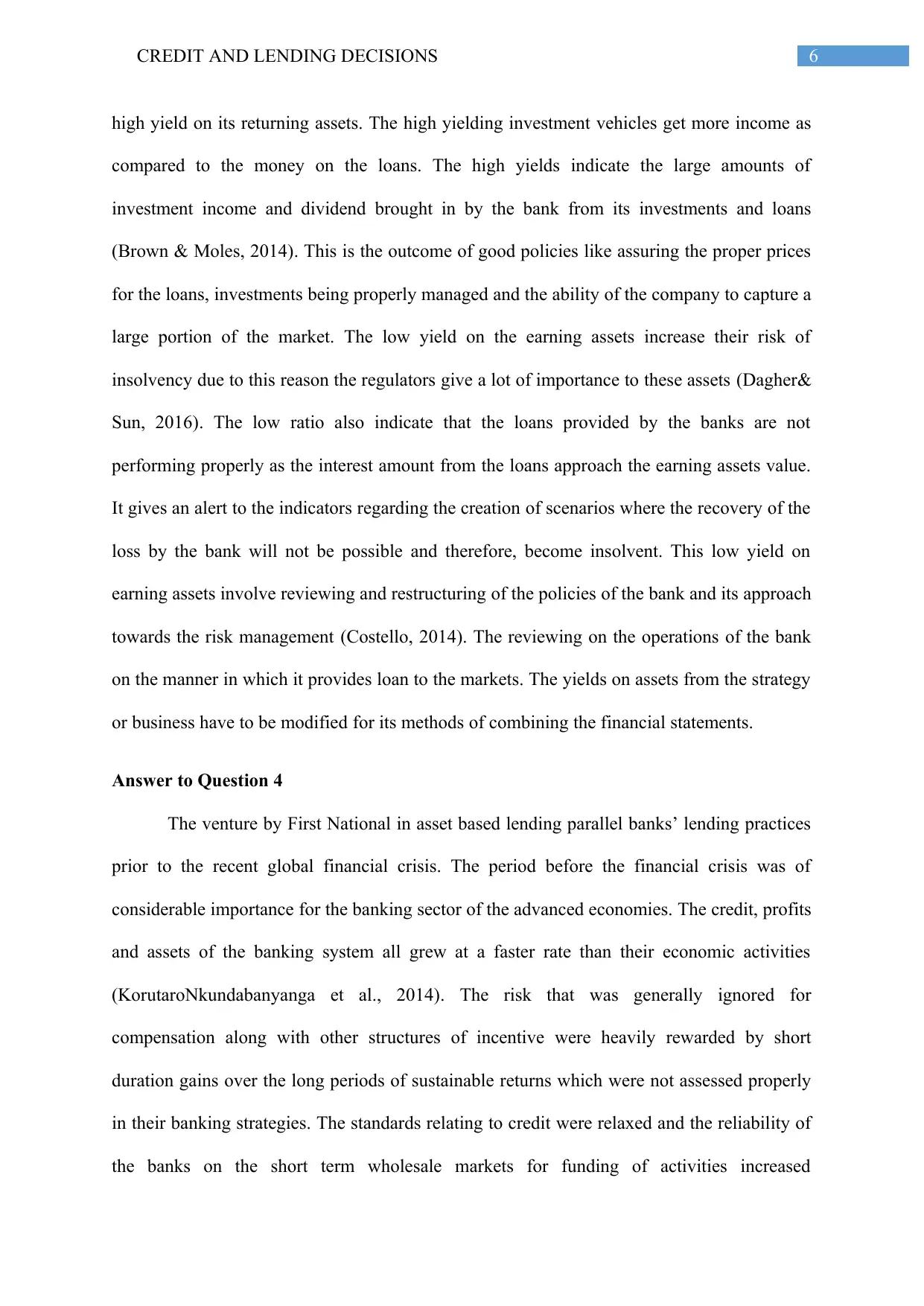
6CREDIT AND LENDING DECISIONS
high yield on its returning assets. The high yielding investment vehicles get more income as
compared to the money on the loans. The high yields indicate the large amounts of
investment income and dividend brought in by the bank from its investments and loans
(Brown & Moles, 2014). This is the outcome of good policies like assuring the proper prices
for the loans, investments being properly managed and the ability of the company to capture a
large portion of the market. The low yield on the earning assets increase their risk of
insolvency due to this reason the regulators give a lot of importance to these assets (Dagher&
Sun, 2016). The low ratio also indicate that the loans provided by the banks are not
performing properly as the interest amount from the loans approach the earning assets value.
It gives an alert to the indicators regarding the creation of scenarios where the recovery of the
loss by the bank will not be possible and therefore, become insolvent. This low yield on
earning assets involve reviewing and restructuring of the policies of the bank and its approach
towards the risk management (Costello, 2014). The reviewing on the operations of the bank
on the manner in which it provides loan to the markets. The yields on assets from the strategy
or business have to be modified for its methods of combining the financial statements.
Answer to Question 4
The venture by First National in asset based lending parallel banks’ lending practices
prior to the recent global financial crisis. The period before the financial crisis was of
considerable importance for the banking sector of the advanced economies. The credit, profits
and assets of the banking system all grew at a faster rate than their economic activities
(KorutaroNkundabanyanga et al., 2014). The risk that was generally ignored for
compensation along with other structures of incentive were heavily rewarded by short
duration gains over the long periods of sustainable returns which were not assessed properly
in their banking strategies. The standards relating to credit were relaxed and the reliability of
the banks on the short term wholesale markets for funding of activities increased
high yield on its returning assets. The high yielding investment vehicles get more income as
compared to the money on the loans. The high yields indicate the large amounts of
investment income and dividend brought in by the bank from its investments and loans
(Brown & Moles, 2014). This is the outcome of good policies like assuring the proper prices
for the loans, investments being properly managed and the ability of the company to capture a
large portion of the market. The low yield on the earning assets increase their risk of
insolvency due to this reason the regulators give a lot of importance to these assets (Dagher&
Sun, 2016). The low ratio also indicate that the loans provided by the banks are not
performing properly as the interest amount from the loans approach the earning assets value.
It gives an alert to the indicators regarding the creation of scenarios where the recovery of the
loss by the bank will not be possible and therefore, become insolvent. This low yield on
earning assets involve reviewing and restructuring of the policies of the bank and its approach
towards the risk management (Costello, 2014). The reviewing on the operations of the bank
on the manner in which it provides loan to the markets. The yields on assets from the strategy
or business have to be modified for its methods of combining the financial statements.
Answer to Question 4
The venture by First National in asset based lending parallel banks’ lending practices
prior to the recent global financial crisis. The period before the financial crisis was of
considerable importance for the banking sector of the advanced economies. The credit, profits
and assets of the banking system all grew at a faster rate than their economic activities
(KorutaroNkundabanyanga et al., 2014). The risk that was generally ignored for
compensation along with other structures of incentive were heavily rewarded by short
duration gains over the long periods of sustainable returns which were not assessed properly
in their banking strategies. The standards relating to credit were relaxed and the reliability of
the banks on the short term wholesale markets for funding of activities increased
Paraphrase This Document
Need a fresh take? Get an instant paraphrase of this document with our AI Paraphraser
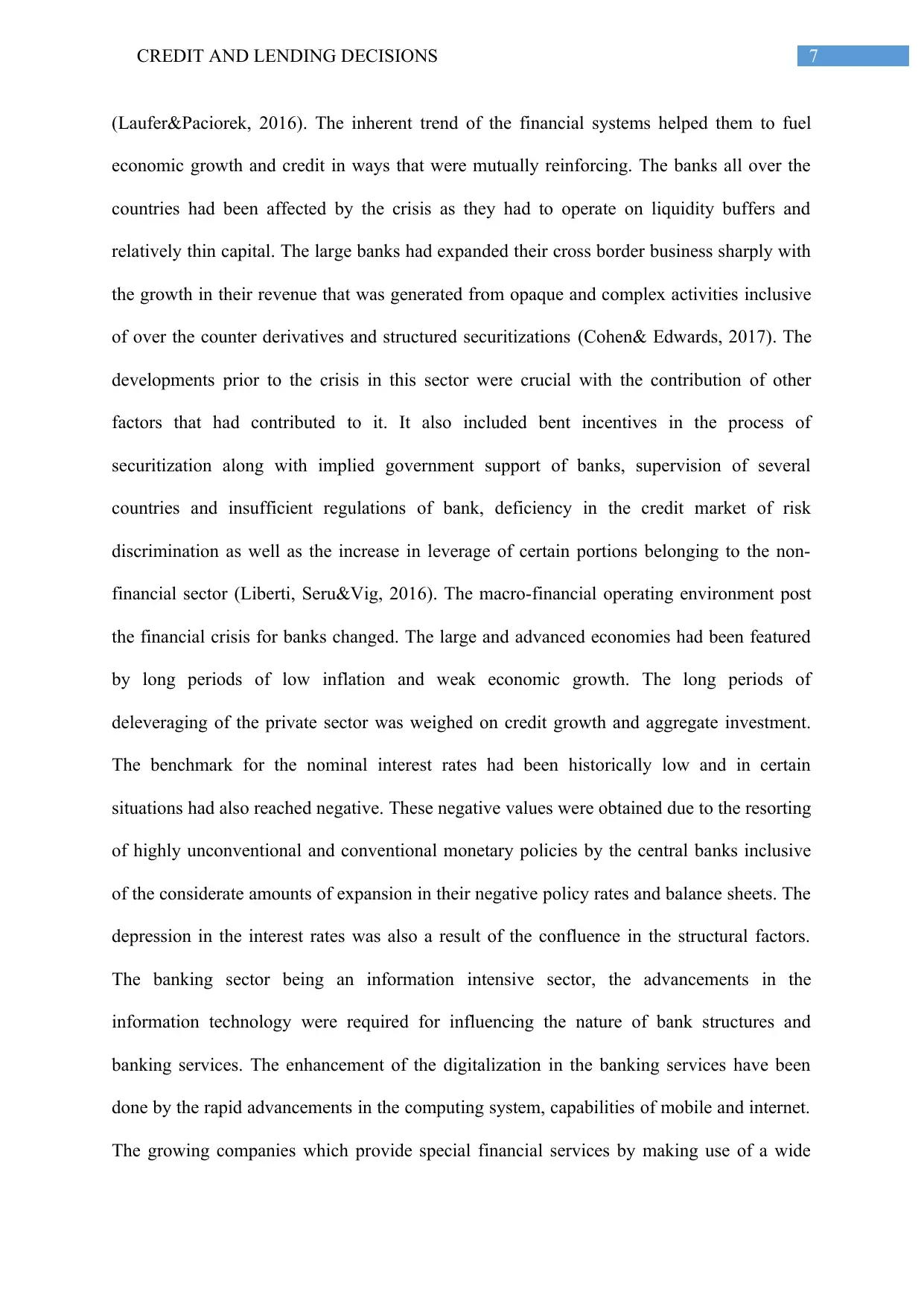
7CREDIT AND LENDING DECISIONS
(Laufer&Paciorek, 2016). The inherent trend of the financial systems helped them to fuel
economic growth and credit in ways that were mutually reinforcing. The banks all over the
countries had been affected by the crisis as they had to operate on liquidity buffers and
relatively thin capital. The large banks had expanded their cross border business sharply with
the growth in their revenue that was generated from opaque and complex activities inclusive
of over the counter derivatives and structured securitizations (Cohen& Edwards, 2017). The
developments prior to the crisis in this sector were crucial with the contribution of other
factors that had contributed to it. It also included bent incentives in the process of
securitization along with implied government support of banks, supervision of several
countries and insufficient regulations of bank, deficiency in the credit market of risk
discrimination as well as the increase in leverage of certain portions belonging to the non-
financial sector (Liberti, Seru&Vig, 2016). The macro-financial operating environment post
the financial crisis for banks changed. The large and advanced economies had been featured
by long periods of low inflation and weak economic growth. The long periods of
deleveraging of the private sector was weighed on credit growth and aggregate investment.
The benchmark for the nominal interest rates had been historically low and in certain
situations had also reached negative. These negative values were obtained due to the resorting
of highly unconventional and conventional monetary policies by the central banks inclusive
of the considerate amounts of expansion in their negative policy rates and balance sheets. The
depression in the interest rates was also a result of the confluence in the structural factors.
The banking sector being an information intensive sector, the advancements in the
information technology were required for influencing the nature of bank structures and
banking services. The enhancement of the digitalization in the banking services have been
done by the rapid advancements in the computing system, capabilities of mobile and internet.
The growing companies which provide special financial services by making use of a wide
(Laufer&Paciorek, 2016). The inherent trend of the financial systems helped them to fuel
economic growth and credit in ways that were mutually reinforcing. The banks all over the
countries had been affected by the crisis as they had to operate on liquidity buffers and
relatively thin capital. The large banks had expanded their cross border business sharply with
the growth in their revenue that was generated from opaque and complex activities inclusive
of over the counter derivatives and structured securitizations (Cohen& Edwards, 2017). The
developments prior to the crisis in this sector were crucial with the contribution of other
factors that had contributed to it. It also included bent incentives in the process of
securitization along with implied government support of banks, supervision of several
countries and insufficient regulations of bank, deficiency in the credit market of risk
discrimination as well as the increase in leverage of certain portions belonging to the non-
financial sector (Liberti, Seru&Vig, 2016). The macro-financial operating environment post
the financial crisis for banks changed. The large and advanced economies had been featured
by long periods of low inflation and weak economic growth. The long periods of
deleveraging of the private sector was weighed on credit growth and aggregate investment.
The benchmark for the nominal interest rates had been historically low and in certain
situations had also reached negative. These negative values were obtained due to the resorting
of highly unconventional and conventional monetary policies by the central banks inclusive
of the considerate amounts of expansion in their negative policy rates and balance sheets. The
depression in the interest rates was also a result of the confluence in the structural factors.
The banking sector being an information intensive sector, the advancements in the
information technology were required for influencing the nature of bank structures and
banking services. The enhancement of the digitalization in the banking services have been
done by the rapid advancements in the computing system, capabilities of mobile and internet.
The growing companies which provide special financial services by making use of a wide
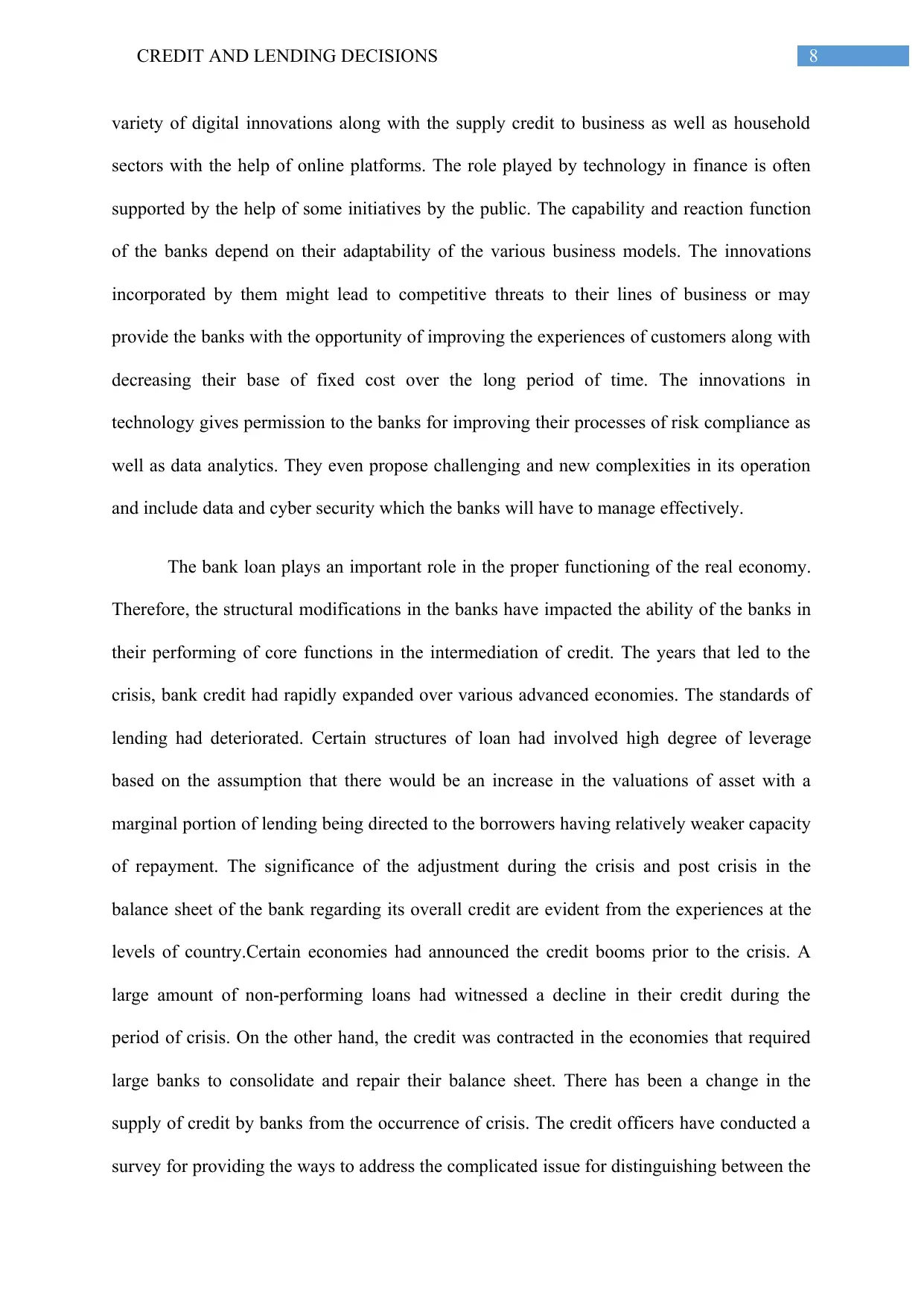
8CREDIT AND LENDING DECISIONS
variety of digital innovations along with the supply credit to business as well as household
sectors with the help of online platforms. The role played by technology in finance is often
supported by the help of some initiatives by the public. The capability and reaction function
of the banks depend on their adaptability of the various business models. The innovations
incorporated by them might lead to competitive threats to their lines of business or may
provide the banks with the opportunity of improving the experiences of customers along with
decreasing their base of fixed cost over the long period of time. The innovations in
technology gives permission to the banks for improving their processes of risk compliance as
well as data analytics. They even propose challenging and new complexities in its operation
and include data and cyber security which the banks will have to manage effectively.
The bank loan plays an important role in the proper functioning of the real economy.
Therefore, the structural modifications in the banks have impacted the ability of the banks in
their performing of core functions in the intermediation of credit. The years that led to the
crisis, bank credit had rapidly expanded over various advanced economies. The standards of
lending had deteriorated. Certain structures of loan had involved high degree of leverage
based on the assumption that there would be an increase in the valuations of asset with a
marginal portion of lending being directed to the borrowers having relatively weaker capacity
of repayment. The significance of the adjustment during the crisis and post crisis in the
balance sheet of the bank regarding its overall credit are evident from the experiences at the
levels of country.Certain economies had announced the credit booms prior to the crisis. A
large amount of non-performing loans had witnessed a decline in their credit during the
period of crisis. On the other hand, the credit was contracted in the economies that required
large banks to consolidate and repair their balance sheet. There has been a change in the
supply of credit by banks from the occurrence of crisis. The credit officers have conducted a
survey for providing the ways to address the complicated issue for distinguishing between the
variety of digital innovations along with the supply credit to business as well as household
sectors with the help of online platforms. The role played by technology in finance is often
supported by the help of some initiatives by the public. The capability and reaction function
of the banks depend on their adaptability of the various business models. The innovations
incorporated by them might lead to competitive threats to their lines of business or may
provide the banks with the opportunity of improving the experiences of customers along with
decreasing their base of fixed cost over the long period of time. The innovations in
technology gives permission to the banks for improving their processes of risk compliance as
well as data analytics. They even propose challenging and new complexities in its operation
and include data and cyber security which the banks will have to manage effectively.
The bank loan plays an important role in the proper functioning of the real economy.
Therefore, the structural modifications in the banks have impacted the ability of the banks in
their performing of core functions in the intermediation of credit. The years that led to the
crisis, bank credit had rapidly expanded over various advanced economies. The standards of
lending had deteriorated. Certain structures of loan had involved high degree of leverage
based on the assumption that there would be an increase in the valuations of asset with a
marginal portion of lending being directed to the borrowers having relatively weaker capacity
of repayment. The significance of the adjustment during the crisis and post crisis in the
balance sheet of the bank regarding its overall credit are evident from the experiences at the
levels of country.Certain economies had announced the credit booms prior to the crisis. A
large amount of non-performing loans had witnessed a decline in their credit during the
period of crisis. On the other hand, the credit was contracted in the economies that required
large banks to consolidate and repair their balance sheet. There has been a change in the
supply of credit by banks from the occurrence of crisis. The credit officers have conducted a
survey for providing the ways to address the complicated issue for distinguishing between the
⊘ This is a preview!⊘
Do you want full access?
Subscribe today to unlock all pages.

Trusted by 1+ million students worldwide
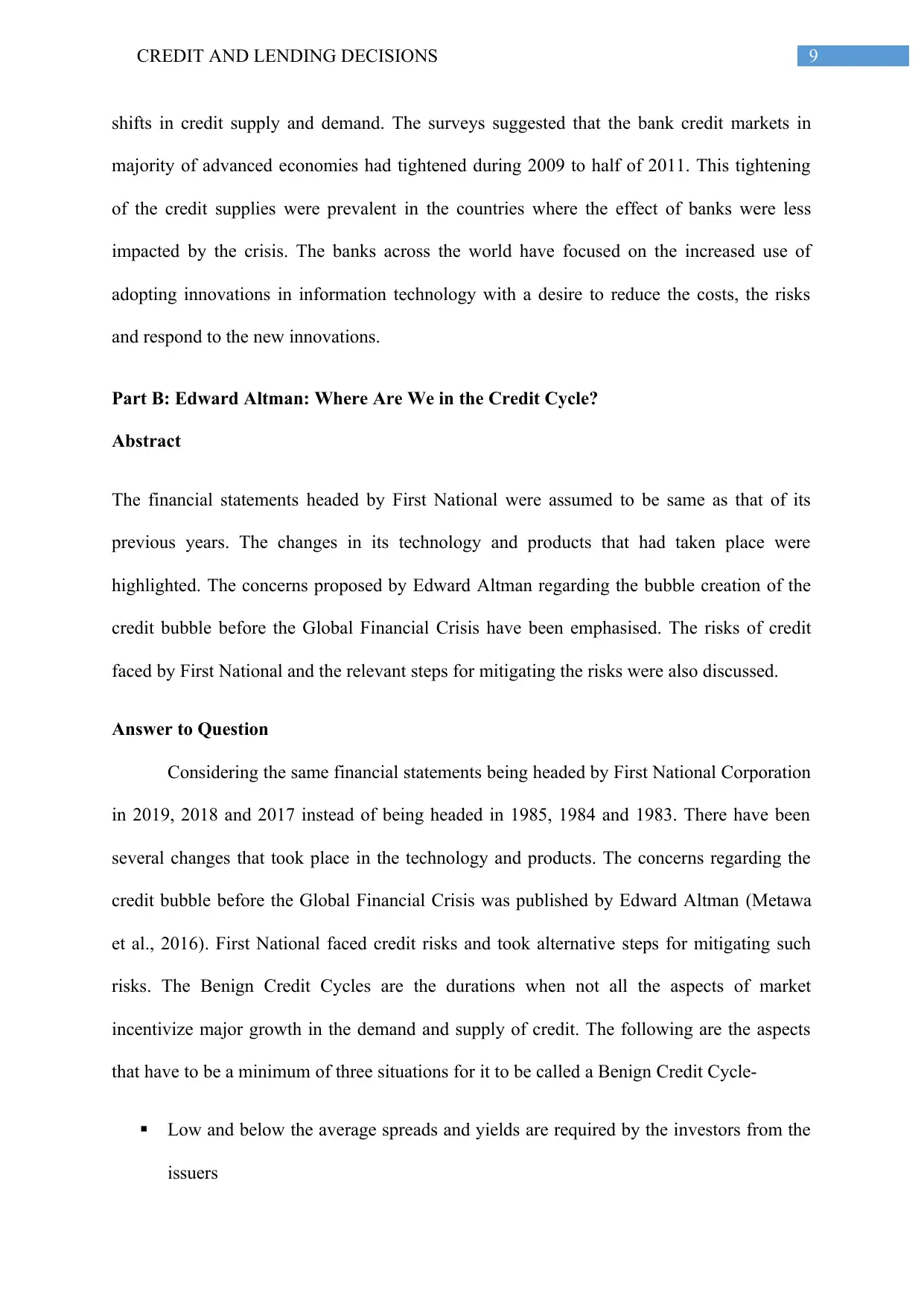
9CREDIT AND LENDING DECISIONS
shifts in credit supply and demand. The surveys suggested that the bank credit markets in
majority of advanced economies had tightened during 2009 to half of 2011. This tightening
of the credit supplies were prevalent in the countries where the effect of banks were less
impacted by the crisis. The banks across the world have focused on the increased use of
adopting innovations in information technology with a desire to reduce the costs, the risks
and respond to the new innovations.
Part B: Edward Altman: Where Are We in the Credit Cycle?
Abstract
The financial statements headed by First National were assumed to be same as that of its
previous years. The changes in its technology and products that had taken place were
highlighted. The concerns proposed by Edward Altman regarding the bubble creation of the
credit bubble before the Global Financial Crisis have been emphasised. The risks of credit
faced by First National and the relevant steps for mitigating the risks were also discussed.
Answer to Question
Considering the same financial statements being headed by First National Corporation
in 2019, 2018 and 2017 instead of being headed in 1985, 1984 and 1983. There have been
several changes that took place in the technology and products. The concerns regarding the
credit bubble before the Global Financial Crisis was published by Edward Altman (Metawa
et al., 2016). First National faced credit risks and took alternative steps for mitigating such
risks. The Benign Credit Cycles are the durations when not all the aspects of market
incentivize major growth in the demand and supply of credit. The following are the aspects
that have to be a minimum of three situations for it to be called a Benign Credit Cycle-
Low and below the average spreads and yields are required by the investors from the
issuers
shifts in credit supply and demand. The surveys suggested that the bank credit markets in
majority of advanced economies had tightened during 2009 to half of 2011. This tightening
of the credit supplies were prevalent in the countries where the effect of banks were less
impacted by the crisis. The banks across the world have focused on the increased use of
adopting innovations in information technology with a desire to reduce the costs, the risks
and respond to the new innovations.
Part B: Edward Altman: Where Are We in the Credit Cycle?
Abstract
The financial statements headed by First National were assumed to be same as that of its
previous years. The changes in its technology and products that had taken place were
highlighted. The concerns proposed by Edward Altman regarding the bubble creation of the
credit bubble before the Global Financial Crisis have been emphasised. The risks of credit
faced by First National and the relevant steps for mitigating the risks were also discussed.
Answer to Question
Considering the same financial statements being headed by First National Corporation
in 2019, 2018 and 2017 instead of being headed in 1985, 1984 and 1983. There have been
several changes that took place in the technology and products. The concerns regarding the
credit bubble before the Global Financial Crisis was published by Edward Altman (Metawa
et al., 2016). First National faced credit risks and took alternative steps for mitigating such
risks. The Benign Credit Cycles are the durations when not all the aspects of market
incentivize major growth in the demand and supply of credit. The following are the aspects
that have to be a minimum of three situations for it to be called a Benign Credit Cycle-
Low and below the average spreads and yields are required by the investors from the
issuers
Paraphrase This Document
Need a fresh take? Get an instant paraphrase of this document with our AI Paraphraser
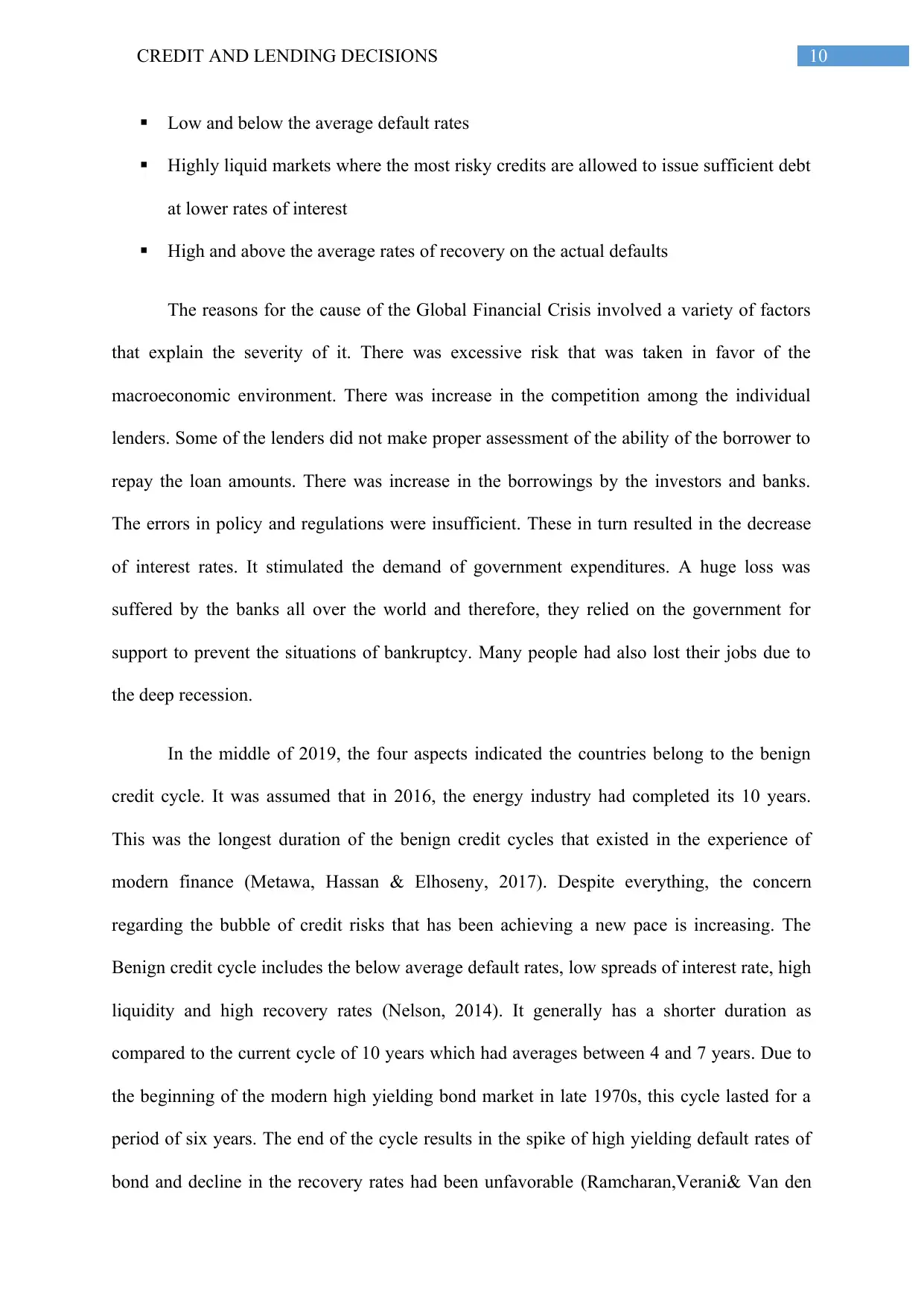
10CREDIT AND LENDING DECISIONS
Low and below the average default rates
Highly liquid markets where the most risky credits are allowed to issue sufficient debt
at lower rates of interest
High and above the average rates of recovery on the actual defaults
The reasons for the cause of the Global Financial Crisis involved a variety of factors
that explain the severity of it. There was excessive risk that was taken in favor of the
macroeconomic environment. There was increase in the competition among the individual
lenders. Some of the lenders did not make proper assessment of the ability of the borrower to
repay the loan amounts. There was increase in the borrowings by the investors and banks.
The errors in policy and regulations were insufficient. These in turn resulted in the decrease
of interest rates. It stimulated the demand of government expenditures. A huge loss was
suffered by the banks all over the world and therefore, they relied on the government for
support to prevent the situations of bankruptcy. Many people had also lost their jobs due to
the deep recession.
In the middle of 2019, the four aspects indicated the countries belong to the benign
credit cycle. It was assumed that in 2016, the energy industry had completed its 10 years.
This was the longest duration of the benign credit cycles that existed in the experience of
modern finance (Metawa, Hassan & Elhoseny, 2017). Despite everything, the concern
regarding the bubble of credit risks that has been achieving a new pace is increasing. The
Benign credit cycle includes the below average default rates, low spreads of interest rate, high
liquidity and high recovery rates (Nelson, 2014). It generally has a shorter duration as
compared to the current cycle of 10 years which had averages between 4 and 7 years. Due to
the beginning of the modern high yielding bond market in late 1970s, this cycle lasted for a
period of six years. The end of the cycle results in the spike of high yielding default rates of
bond and decline in the recovery rates had been unfavorable (Ramcharan,Verani& Van den
Low and below the average default rates
Highly liquid markets where the most risky credits are allowed to issue sufficient debt
at lower rates of interest
High and above the average rates of recovery on the actual defaults
The reasons for the cause of the Global Financial Crisis involved a variety of factors
that explain the severity of it. There was excessive risk that was taken in favor of the
macroeconomic environment. There was increase in the competition among the individual
lenders. Some of the lenders did not make proper assessment of the ability of the borrower to
repay the loan amounts. There was increase in the borrowings by the investors and banks.
The errors in policy and regulations were insufficient. These in turn resulted in the decrease
of interest rates. It stimulated the demand of government expenditures. A huge loss was
suffered by the banks all over the world and therefore, they relied on the government for
support to prevent the situations of bankruptcy. Many people had also lost their jobs due to
the deep recession.
In the middle of 2019, the four aspects indicated the countries belong to the benign
credit cycle. It was assumed that in 2016, the energy industry had completed its 10 years.
This was the longest duration of the benign credit cycles that existed in the experience of
modern finance (Metawa, Hassan & Elhoseny, 2017). Despite everything, the concern
regarding the bubble of credit risks that has been achieving a new pace is increasing. The
Benign credit cycle includes the below average default rates, low spreads of interest rate, high
liquidity and high recovery rates (Nelson, 2014). It generally has a shorter duration as
compared to the current cycle of 10 years which had averages between 4 and 7 years. Due to
the beginning of the modern high yielding bond market in late 1970s, this cycle lasted for a
period of six years. The end of the cycle results in the spike of high yielding default rates of
bond and decline in the recovery rates had been unfavorable (Ramcharan,Verani& Van den
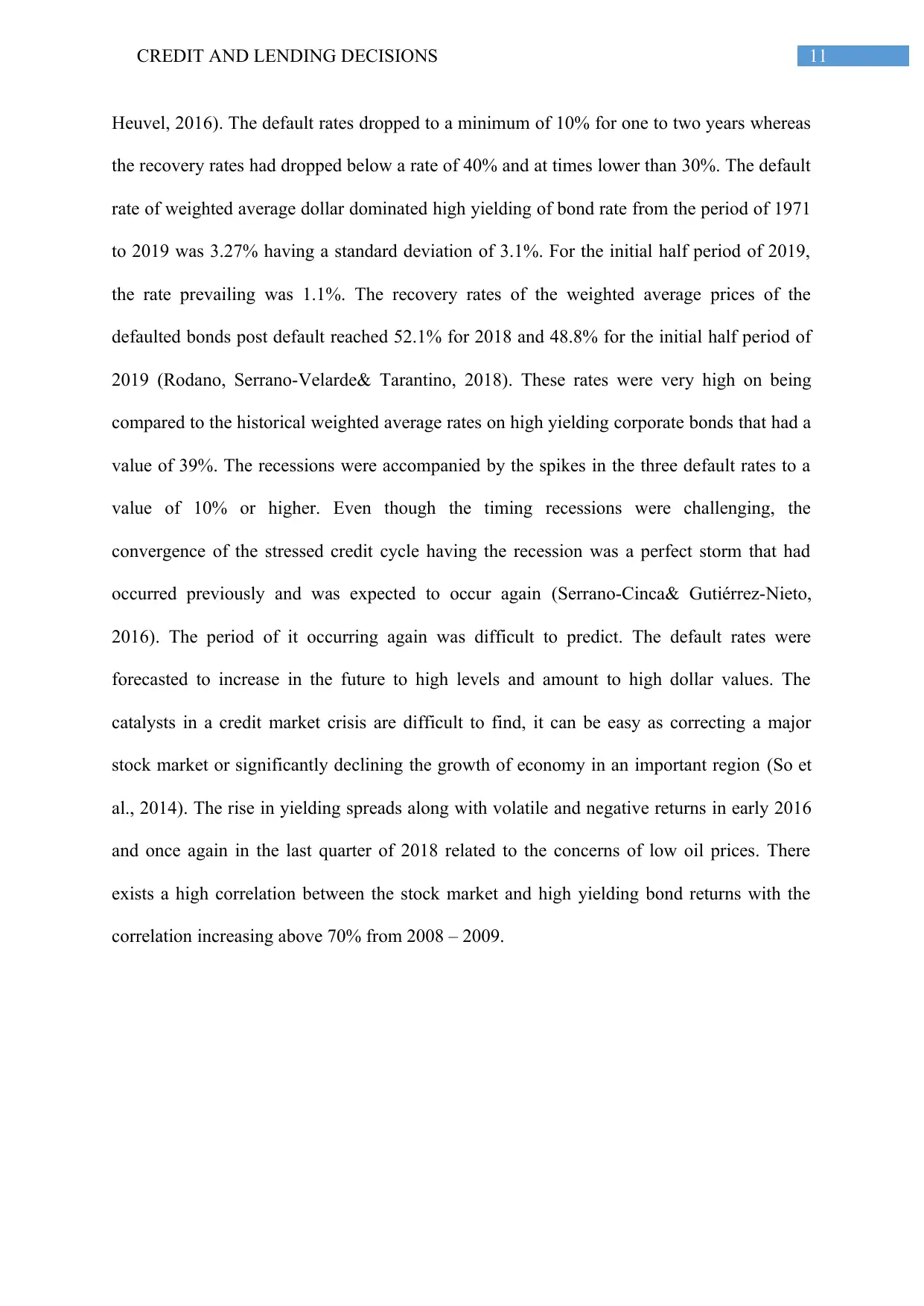
11CREDIT AND LENDING DECISIONS
Heuvel, 2016). The default rates dropped to a minimum of 10% for one to two years whereas
the recovery rates had dropped below a rate of 40% and at times lower than 30%. The default
rate of weighted average dollar dominated high yielding of bond rate from the period of 1971
to 2019 was 3.27% having a standard deviation of 3.1%. For the initial half period of 2019,
the rate prevailing was 1.1%. The recovery rates of the weighted average prices of the
defaulted bonds post default reached 52.1% for 2018 and 48.8% for the initial half period of
2019 (Rodano, Serrano-Velarde& Tarantino, 2018). These rates were very high on being
compared to the historical weighted average rates on high yielding corporate bonds that had a
value of 39%. The recessions were accompanied by the spikes in the three default rates to a
value of 10% or higher. Even though the timing recessions were challenging, the
convergence of the stressed credit cycle having the recession was a perfect storm that had
occurred previously and was expected to occur again (Serrano-Cinca& Gutiérrez-Nieto,
2016). The period of it occurring again was difficult to predict. The default rates were
forecasted to increase in the future to high levels and amount to high dollar values. The
catalysts in a credit market crisis are difficult to find, it can be easy as correcting a major
stock market or significantly declining the growth of economy in an important region (So et
al., 2014). The rise in yielding spreads along with volatile and negative returns in early 2016
and once again in the last quarter of 2018 related to the concerns of low oil prices. There
exists a high correlation between the stock market and high yielding bond returns with the
correlation increasing above 70% from 2008 – 2009.
Heuvel, 2016). The default rates dropped to a minimum of 10% for one to two years whereas
the recovery rates had dropped below a rate of 40% and at times lower than 30%. The default
rate of weighted average dollar dominated high yielding of bond rate from the period of 1971
to 2019 was 3.27% having a standard deviation of 3.1%. For the initial half period of 2019,
the rate prevailing was 1.1%. The recovery rates of the weighted average prices of the
defaulted bonds post default reached 52.1% for 2018 and 48.8% for the initial half period of
2019 (Rodano, Serrano-Velarde& Tarantino, 2018). These rates were very high on being
compared to the historical weighted average rates on high yielding corporate bonds that had a
value of 39%. The recessions were accompanied by the spikes in the three default rates to a
value of 10% or higher. Even though the timing recessions were challenging, the
convergence of the stressed credit cycle having the recession was a perfect storm that had
occurred previously and was expected to occur again (Serrano-Cinca& Gutiérrez-Nieto,
2016). The period of it occurring again was difficult to predict. The default rates were
forecasted to increase in the future to high levels and amount to high dollar values. The
catalysts in a credit market crisis are difficult to find, it can be easy as correcting a major
stock market or significantly declining the growth of economy in an important region (So et
al., 2014). The rise in yielding spreads along with volatile and negative returns in early 2016
and once again in the last quarter of 2018 related to the concerns of low oil prices. There
exists a high correlation between the stock market and high yielding bond returns with the
correlation increasing above 70% from 2008 – 2009.
⊘ This is a preview!⊘
Do you want full access?
Subscribe today to unlock all pages.

Trusted by 1+ million students worldwide
1 out of 19
Related Documents
Your All-in-One AI-Powered Toolkit for Academic Success.
+13062052269
info@desklib.com
Available 24*7 on WhatsApp / Email
![[object Object]](/_next/static/media/star-bottom.7253800d.svg)
Unlock your academic potential
Copyright © 2020–2025 A2Z Services. All Rights Reserved. Developed and managed by ZUCOL.





